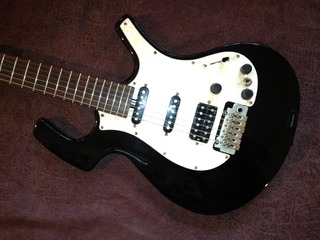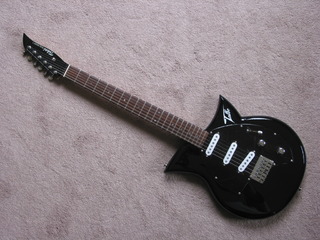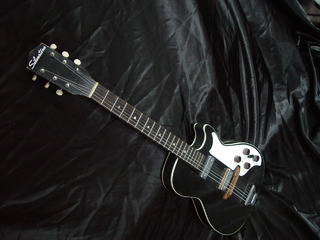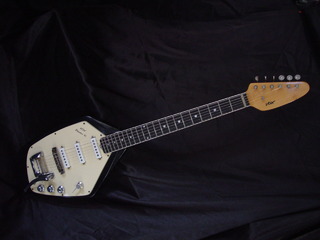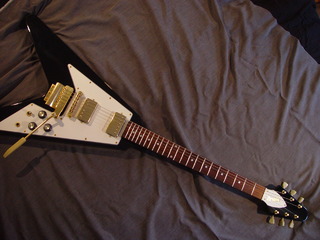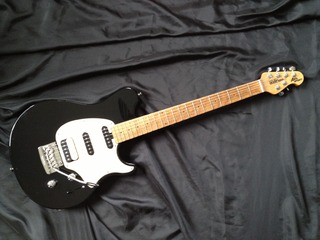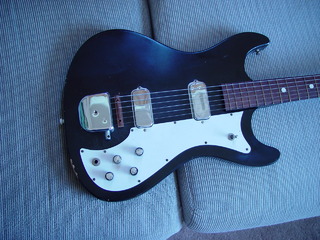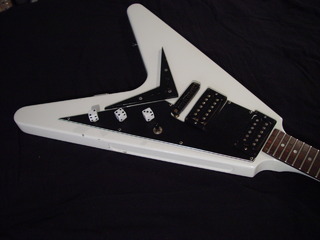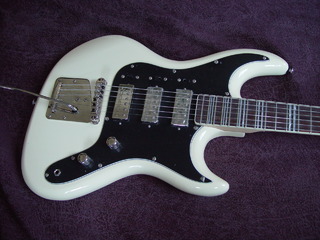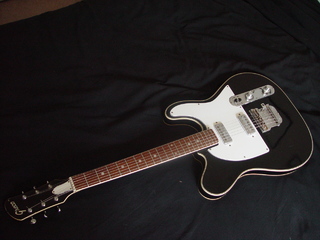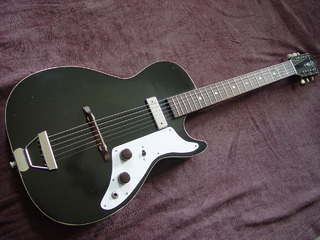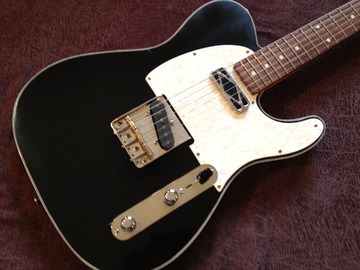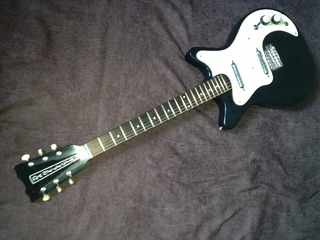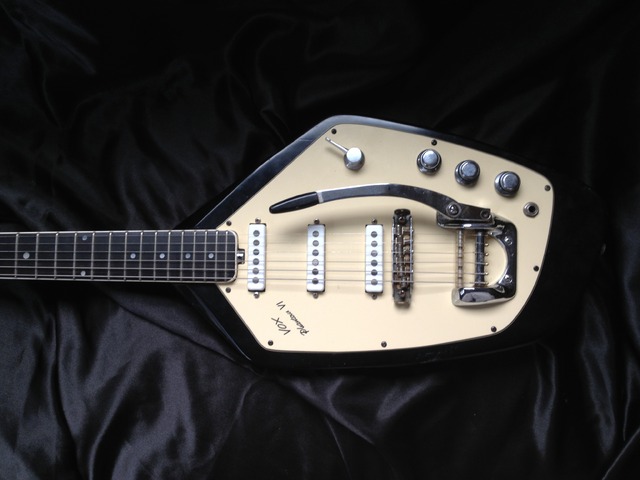Quest for tone.
 Friday, August 23, 2013 at 11:02AM
Friday, August 23, 2013 at 11:02AM Vox Phantom VI
This bad boy has been with me for a while but in a dozen pieces. Over the years I've been scarfing up original parts on eBay or wherever I could find them until I had everything I needed for a complete restoration. The last procurement was the custom made pickguard with the Vox Phantom VI logo engraved in the correct script which was not a trivial acquisition. Since this is a restoration I took the liberty of making a few improvement as these old Vox's were plagued with a few design quirks that kept them from optimum performance. The first thing I changed was the zero fret; A holdover from a bygone era that's not consistent with modern setup techniques. I replaced the zero fret with an oversized nut made of high tech type of nylon that is actually harder than bone. It was tremendously difficult to cut because of its hardness. Another quirk of these guitars was that the tone controls were wired up to rotate backwards with two tone controls located infront of a single volume control. I corrected the direction of rotation of the tone controls but left the positioning of the controls as original. The fretwork has been upgraded with wider modern fret wire and is carefully manicured. The upshot is this baby plays way better than it did back in the 60's. Playing this guitar through a clean amp with a little reverb really does sound like the Beatles due to the unique sound of the Vox Pickups.
 Wednesday, July 31, 2013 at 7:52PM
Wednesday, July 31, 2013 at 7:52PM Harmony Brilliant H1310
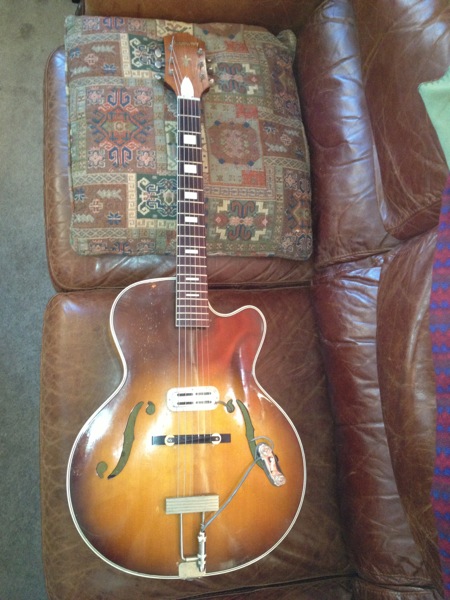
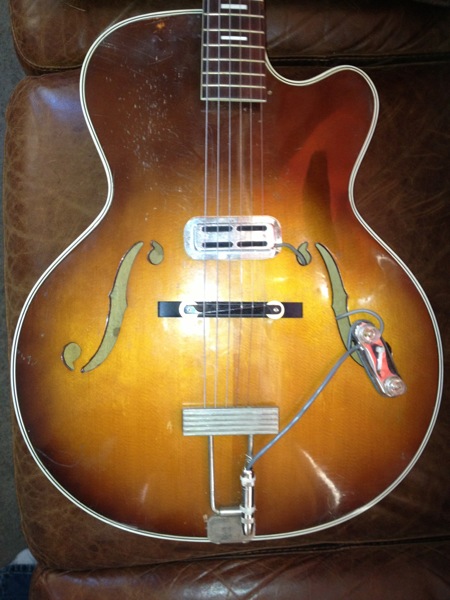
Awesome guitar I brought it back from the dead. Unfortunately it was in two pieces when I got it back. All better now (with a DeArmond pickup for added utility).
 Friday, March 22, 2013 at 2:50PM
Friday, March 22, 2013 at 2:50PM Humbuckers
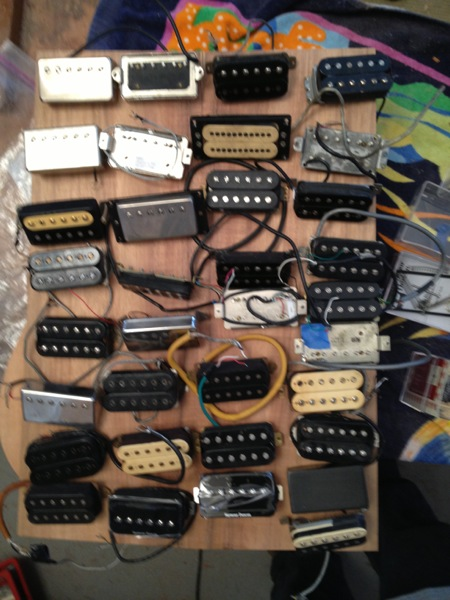
You could say I'm picky about pickups. These are just the humbuckers. Some I've tried and put aside, some I haven't gotten around to yet. Since the current crop of guitars I'm building have all used single coils the humbuckers drawer hasn't seen much action.
 Friday, February 8, 2013 at 3:33PM
Friday, February 8, 2013 at 3:33PM Les Paul Telecaster Hybrid Guitars
I've been fascinated by the concept of a Vintage Les Paul/Telecaster hybrid type guitar for as long as I can remember. Only single coil pickups and nitro lacquer will do. The earliest Les Pauls used what arguably are one of the ballsiest sounding pickups ever, the P-90. These pickups produce a type of thick and chewy tone that humbucking pickups can only hint at. They have a purity of tone that cuts through a dense mix or sound stage. I have good reason to be in love with this tone having owned a P-90 equipped 1954 Les Paul since 1985.Here's a photo of me with it in action from back around that time. This phot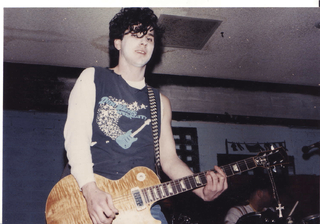 Note the deep 3D flame on that 54 Les Paulo shows it when I was experimenting with mini humbuckers as they fit perfectly in a P-90 rout with the rings as shown. I didn't have those mini humbuckers in there for very long. Don't be fooled by that 3D looking flame either. That flamed figure was only over 2/3rds of the guitar as these were originally all gold tops or all gold finish guitars. They didn't start with the sunburst Les Pauls until 1958.
Note the deep 3D flame on that 54 Les Paulo shows it when I was experimenting with mini humbuckers as they fit perfectly in a P-90 rout with the rings as shown. I didn't have those mini humbuckers in there for very long. Don't be fooled by that 3D looking flame either. That flamed figure was only over 2/3rds of the guitar as these were originally all gold tops or all gold finish guitars. They didn't start with the sunburst Les Pauls until 1958.
There are a few differences between the Gibson Les Paul construction and the Fender Telecaster that are of note when making comparisons The biggest difference being that the Les Paul is constructed with a set neck, where it is glued into the body. The Telecaster has a bolt on neck. You might think that the set neck construction method is superior but the glue involved with that can make for an inferior joint acting as tonal insulation. A related concept that sometimes gets overlooked is that the guitar neck is a big part of the overall tone produced by any guitar. With a bolt on neck you have wood to wood contact with no glue to get in the way of sound transfer. The types of wood used is drastically different between the two guitars as well. There are other differences such as the scale length. The Gibson scale length is 24 and 3/4 inches. The Fender scale length is 25 and 1/2 inches. This makes a difference in string tension, playability and ultimately in the tone produced. One is not superior to the other, but it does make a difference. Other differences are that on the Telecaster the strings are anchored through the body. They actually pass completely through the body when you install them. Where as on the Les Paul the strings are anchored on a tail piece that is bolted to the top of the guitar. The pickups and control circuit are different on each guitar as well. These are most of the factors that must be interpreted when trying to construct a hybrid instrument. I'm not at all decided on what are the best attributes to carry over from each one. That's why I am building a line of these hybrids where I am mixing and matching the attributes from both types. I am sticking with the Telecaster shape but other than that its all fair game. Here are a few photos of a few I've produced so far and the results have been fantastic. These all have a Fender scale length of 25.5" and have drop tops or carved tops. 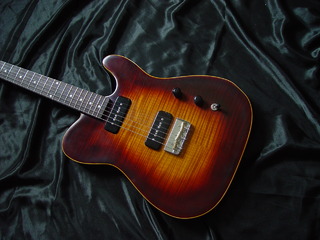 click on an image for full size
click on an image for full size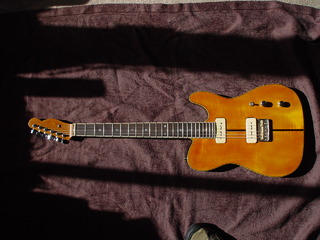 There are a few other attribute differences worth mentioning. Vintage Les Pauls are generally constructed out of Honduran or African mahogany. Telecasters were made of ash and/or alder with maple necks. Les Paul bodies were capped with a carved maple top, about 5/8ths of an inch thick at its thickest points. These made for lots of tonal differences between the two. I am having a lot of fun building these hybrids. I have a few coming soon with highly figured book matched koa wood tops. Koa is known for its deep 3d figure and great tonal properties. Lots of other choices are involved with these builds and I will try to keep you posted of my progress.
There are a few other attribute differences worth mentioning. Vintage Les Pauls are generally constructed out of Honduran or African mahogany. Telecasters were made of ash and/or alder with maple necks. Les Paul bodies were capped with a carved maple top, about 5/8ths of an inch thick at its thickest points. These made for lots of tonal differences between the two. I am having a lot of fun building these hybrids. I have a few coming soon with highly figured book matched koa wood tops. Koa is known for its deep 3d figure and great tonal properties. Lots of other choices are involved with these builds and I will try to keep you posted of my progress.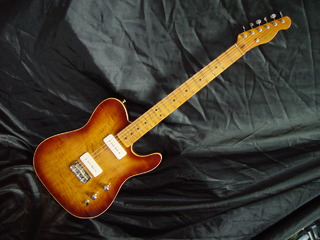
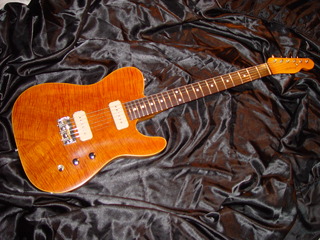
Thanks for looking!
If you see something here you agree with or disagree with and want to have a say, feel free to post a comment. Please remember this is also a commercial website and we can't allow posts or comments to persist that are offensive or that interfere with the commercial aspect of this site.
